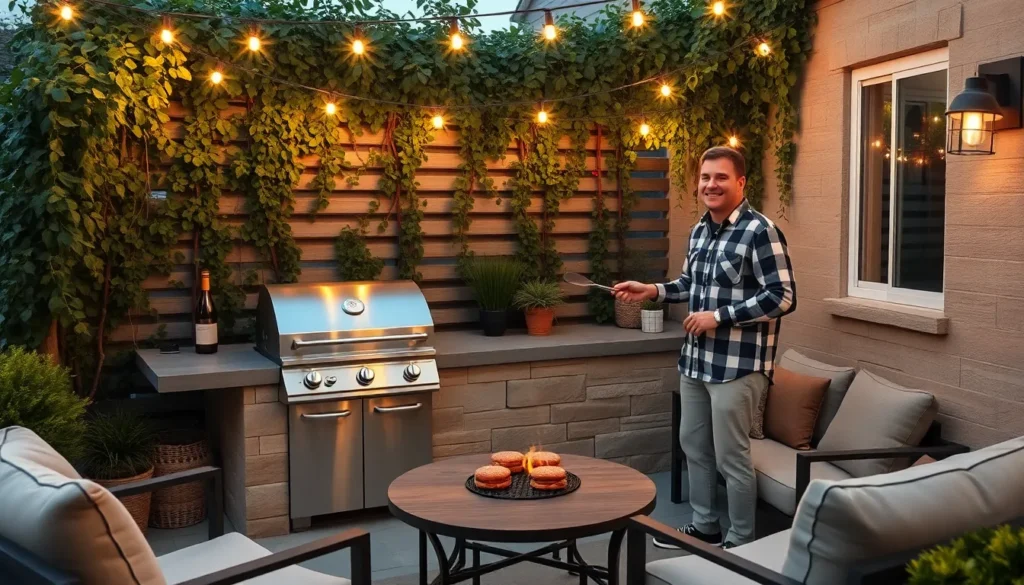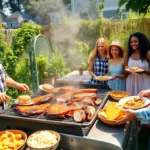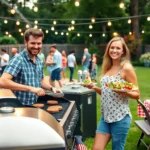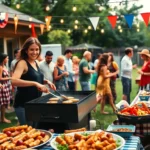We’ve all been there – staring at that awkward corner of our backyard wondering how to make it work for us. Those neglected spaces often hold the most potential for creating something truly special. When we transform unused corners into dedicated BBQ areas we’re not just maximizing our outdoor space – we’re creating the perfect gathering spot for family cookouts and weekend entertaining.
Corner BBQ setups offer unique advantages that straight-line configurations simply can’t match. We get natural wind protection built-in privacy and the opportunity to create cozy intimate cooking spaces that feel intentionally designed rather than thrown together. The angular layout also gives us more counter space and storage options while keeping everything within arm’s reach.
Whether we’re working with a tiny patio corner or a sprawling backyard angle the key lies in understanding how to leverage these spaces effectively. From space-saving grill placement to clever storage answers we’ll explore practical ideas that turn your corner into the ultimate outdoor cooking destination.
Create a Cozy Corner Fire Pit BBQ Setup
Corner fire pit BBQ setups combine the warmth of a traditional fire with practical cooking capabilities. These dual-purpose installations maximize your corner space while creating an inviting focal point for outdoor entertainment.
Choose Heat-Resistant Materials for Safety
Fire bricks form the foundation of any safe corner fire pit BBQ setup, withstanding temperatures up to 2,000°F without cracking or deteriorating. We recommend using standard fire bricks measuring 9″ x 4.5″ x 2.5″ for the firebox construction, as they provide excellent heat retention and distribution.
Natural stone options like granite and slate offer both durability and aesthetic appeal for your corner BBQ area. Granite countertops can handle direct heat exposure up to 1,200°F, making them perfect for food preparation surfaces adjacent to your fire pit. Slate provides a non-slip surface that remains cool to the touch even when positioned near high-heat areas.
Stainless steel components resist corrosion and maintain their appearance even though constant exposure to heat and moisture. Choose 304-grade stainless steel for grill grates, cooking surfaces, and storage compartments, as this alloy contains 18% chromium and 8% nickel for superior rust resistance.
Refractory concrete creates custom shapes while maintaining structural integrity under extreme temperature changes. This specialized concrete mixture contains alumina cement and heat-resistant aggregates, allowing you to build curved walls or unique corner configurations that standard bricks can’t accommodate.
Position Seating in a Semi-Circle Layout
Semi-circle seating arrangements create intimate gathering spaces that naturally encourage conversation while keeping everyone within comfortable distance of the fire pit’s warmth. Position built-in benches or movable chairs in a 180-degree arc, leaving the cooking side open for easy access.
Distance seating 6 to 8 feet from the fire pit to ensure optimal heat distribution without overwhelming guests with excessive warmth. This spacing allows people to enjoy the fire’s ambiance while maintaining comfortable temperatures for extended gatherings.
Incorporate different seating heights to add visual interest and accommodate various preferences. Combine standard 18-inch height chairs with 24-inch bar stools and 12-inch bench seating to create ever-changing levels around your corner fire pit.
Include side tables between seating groups for convenient placement of drinks, plates, and personal items. These surfaces should be constructed from the same heat-resistant materials as your BBQ setup, ensuring they can withstand occasional ember contact.
Add Ambient Lighting for Evening Gatherings
String lights create magical overhead illumination that extends your corner BBQ area’s usability well into the evening hours. Install weatherproof LED string lights with warm white bulbs (2700K color temperature) along fence lines or between posts to achieve even light distribution.
Solar-powered path lights guide movement around your corner fire pit setup while conserving electricity. Position these fixtures every 4 to 6 feet along walkways and around seating areas, choosing models with automatic dusk-to-dawn sensors for hands-free operation.
Built-in LED strip lighting under countertops provides task lighting for food preparation while adding a contemporary glow to your corner BBQ area. Install color-changing RGB strips with dimming capabilities, allowing you to adjust the mood from bright white for cooking to warm amber for relaxation.
Portable lanterns offer flexible lighting options that you can move as needed throughout your corner space. Battery-powered models with flameless candle effects create cozy ambiance without fire safety concerns, while rechargeable camping lanterns provide bright task lighting when needed.
Design a Modern L-Shaped Corner Grill Station

An L-shaped layout maximizes corner space efficiency while creating distinct zones for grilling, prep, and serving. This configuration facilitates smooth flow during cooking and socializing, making it perfect for modern outdoor entertaining.
Install Built-In Storage for Grilling Tools
Built-in cabinets beneath your counter keep utensils, spices, and grilling accessories organized and within reach. Weather-resistant storage options using stainless steel or treated wood protect your tools from outdoor elements throughout the seasons.
Modular designs allow customization and flexibility to suit your exact storage needs. Drawers with dividers help organize different types of grilling tools, while dedicated spaces for propane tanks and cleaning supplies maintain a clutter-free cooking environment.
Incorporate Counter Space for Food Prep
Sufficient counter space adjacent to your grill enables easy food preparation, plating, and staging during cooking sessions. Durable surfaces like granite, concrete, or stainless steel withstand outdoor conditions while providing ample workspace for meal preparation.
Under-counter refrigeration keeps ingredients cool and accessible without requiring trips back to your indoor kitchen. Strategic placement of prep areas ensures efficient workflow from food preparation to grilling to serving your guests.
Select Weather-Resistant Appliances
High-quality stainless steel grills and appliances designed specifically for outdoor durability resist rust and moisture damage. Built-in grills with sealed burners and covered controls maintain functionality even though exposure to various weather conditions.
Weatherproof lighting extends your BBQ area’s usability after dark while improving the overall ambiance. Consider positioning your grill based on prevailing wind direction to keep smoke away from seating areas and your home’s interior spaces.
Build a Rustic Stone Corner BBQ Pit
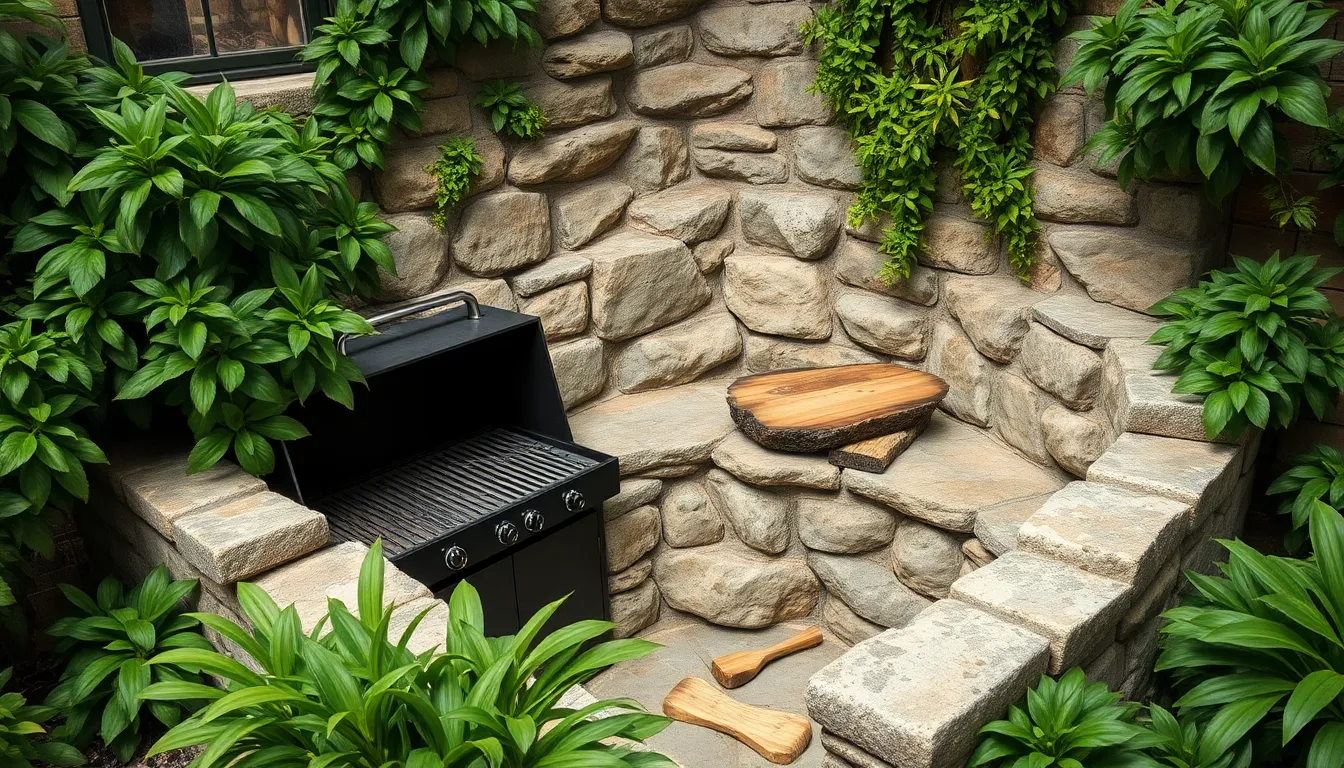
Natural stone construction transforms corner spaces into timeless outdoor cooking destinations that withstand decades of use. We’ll explore essential elements that create both functional cooking areas and stunning visual centerpieces.
Use Natural Stone for Authentic Appeal
Natural stones like bluestone, sandstone, and flagstone deliver earthy colors and textures that seamlessly blend with outdoor environments. These materials create authentic rustic charm while providing exceptional durability against weather elements and high heat exposure.
Fieldstone offers rugged texture with its irregular shapes and natural weathering patterns. We recommend selecting stones with consistent color palettes to maintain visual cohesion throughout your BBQ pit design.
Stone countertops extend the natural aesthetic beyond the fire box into prep and serving areas. Combining multiple stone elements creates a unified design that feels integrated rather than assembled from separate components.
Create Multiple Cooking Zones
Multiple cooking zones maximize functionality by accommodating different cooking methods simultaneously. Design your corner pit with dedicated areas for charcoal grilling, wood-fired cooking, and food preparation to streamline outdoor meal preparation.
Charcoal grill sections provide traditional BBQ flavors while wood-fired areas accommodate pizza ovens or smoker boxes. Positioning these zones side by side within the stone structure maintains workflow efficiency during busy cooking sessions.
Prep space between cooking areas prevents cross-contamination and provides staging areas for ingredients and finished dishes. Stone construction allows seamless integration of these zones while maintaining the rustic aesthetic throughout the entire cooking area.
Add a Chimney for Proper Ventilation
Stone chimneys direct smoke away from cooking and seating areas while maintaining architectural harmony with your BBQ pit design. Proper ventilation prevents smoke accumulation that could make outdoor dining uncomfortable for guests.
Building the chimney from matching natural stone preserves visual unity while serving essential safety functions. Height requirements typically range from 8-12 feet above the cooking surface to ensure adequate draft and smoke dispersal.
Ventilation planning should account for prevailing wind patterns in your exact location. We suggest consulting local building codes before finalizing chimney dimensions and placement to ensure compliance with safety regulations.
Maximize Small Spaces with Vertical Corner BBQ Ideas
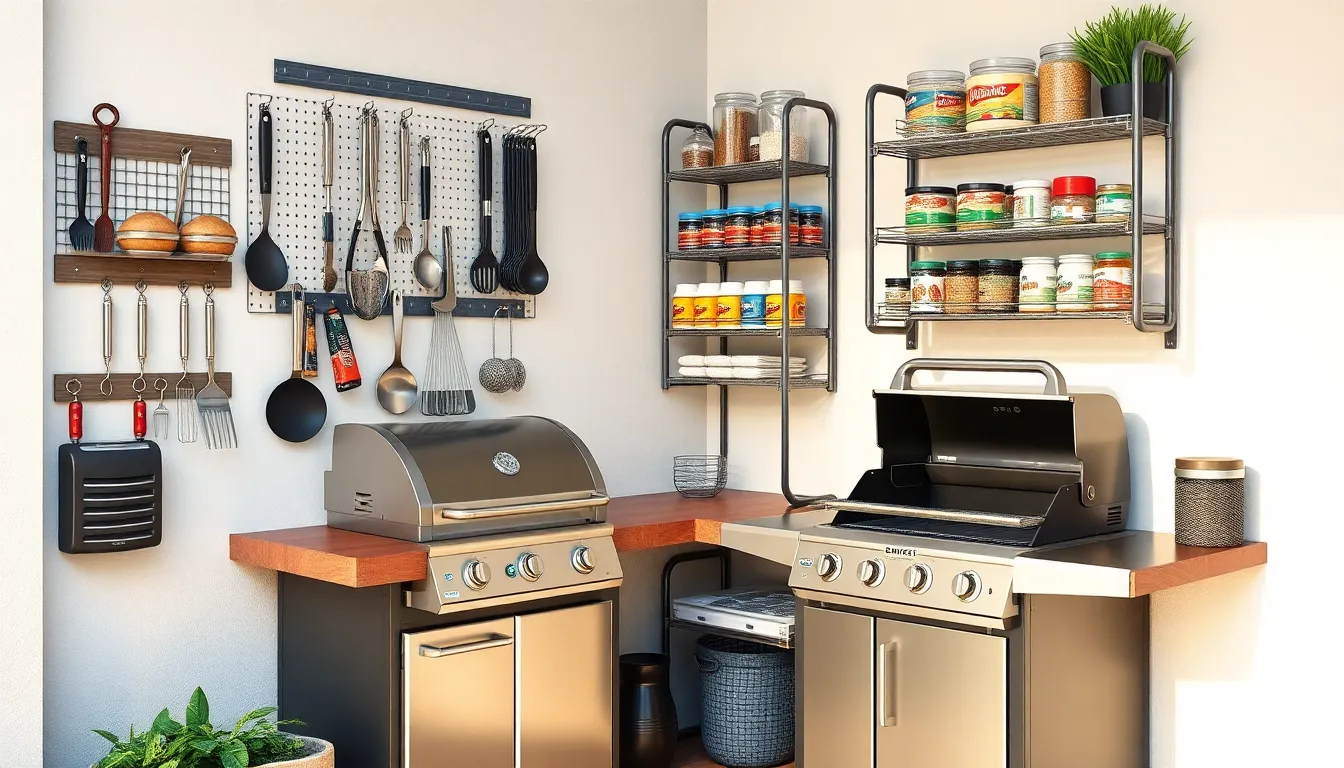
Vertical storage transforms cramped corner BBQ areas into highly functional cooking spaces. When we use upward space effectively, we can create multiple zones for cooking, storage, and prep work without expanding our footprint.
Install Wall-Mounted Grill Accessories
Wall-mounted accessories keep essential grilling tools organized and easily accessible while preserving valuable counter space. We recommend installing magnetic strips for knives, hooks for spatulas and tongs, and small shelves for spice containers. These installations create a clutter-free environment that’s especially important in confined outdoor corners.
Spice racks mounted on adjacent walls provide immediate access to seasonings without taking up prep space. Tool holders positioned at arm’s reach from the grill eliminate the need to walk back and forth during cooking sessions. Weather-resistant mounting hardware ensures these accessories withstand outdoor conditions while maintaining their functionality.
Use Stackable Storage Answers
Stackable storage units maximize vertical space without requiring permanent installations in corner BBQ areas. We can stack modular shelving units to hold charcoal, grilling supplies, and cooking equipment in an organized tower format. These units adapt to changing storage needs and relocate easily when we redesign our outdoor space.
Plastic bins stack securely to store seasonal items like grill covers, extra utensils, and cleaning supplies. Metal wire baskets create ventilated storage for items that need air circulation, such as wood chips or charcoal. Modular drawer systems stack to create organized compartments for different types of grilling accessories.
Create Multi-Level Cooking Surfaces
Multi-tiered surfaces separate cooking, prepping, and serving zones vertically to streamline our grilling workflow. We can install a primary grill at standard height with raised shelves above for finished dishes and lower prep areas for ingredient organization. This vertical separation prevents cross-contamination while keeping everything within easy reach.
Tiered counter systems create distinct zones for different cooking stages, from raw ingredient prep to final plating. We position the main cooking surface at comfortable working height with auxiliary surfaces at varying levels to accommodate different tasks. Built-in cutting boards at different heights allow multiple people to work simultaneously without interfering with the primary grilling area.
Transform Your Corner with a Pergola BBQ Area

Pergolas create the perfect architectural foundation for corner BBQ areas by providing both style and functionality. We’ll explore how this overhead structure can transform your underutilized corner into a comfortable outdoor cooking destination.
Build Overhead Structure for Shade
Building a pergola overhead structure maximizes your corner BBQ area’s usability during sunny or rainy weather conditions. This semi-covered design protects you from direct sunlight while maintaining an open, airy atmosphere that doesn’t feel enclosed. We recommend positioning the pergola to cover both your grilling station and dining area for complete protection.
Installing this overhead framework allows for longer outdoor cooking sessions without worrying about harsh weather elements. The structure creates a defined space that feels intentional and well-planned rather than just a grill thrown in a corner. Most pergolas can accommodate additional features like hanging planters, lighting fixtures, or even outdoor speakers to enhance your BBQ experience.
Install Outdoor Curtains for Privacy
Installing outdoor curtains on your pergola posts creates instant privacy and wind protection for your corner BBQ area. These fabric panels allow you to control light levels throughout the day while adding a soft, elegant touch to your outdoor cooking space. We suggest using weather-resistant materials that can withstand UV exposure and moisture without fading or deteriorating.
Outdoor curtains make your BBQ corner feel more intimate and protected from neighbors’ views during gatherings. They’re particularly useful for controlling wind that might affect your grilling temperature or blow smoke toward seating areas. Consider installing curtains on pulleys or rings so you can easily adjust them based on weather conditions and privacy needs.
Add Climbing Plants for Natural Beauty
Adding climbing plants to your pergola posts creates natural beauty while softening the hard lines of built structures. Vines and flowering creepers provide seasonal colors and pleasant scents that enhance your BBQ area’s ambiance throughout the year. We recommend selecting plants that thrive in your climate zone and don’t require excessive maintenance during grilling season.
Climbing plants contribute additional shade as they mature, creating a more comfortable environment for extended outdoor cooking sessions. Popular options include clematis, wisteria, and grapevines, which offer both aesthetic appeal and practical benefits. These living elements help your corner BBQ area blend seamlessly with your industry while creating a more inviting atmosphere for entertaining guests.
Design a Corner BBQ Kitchen with Full Amenities
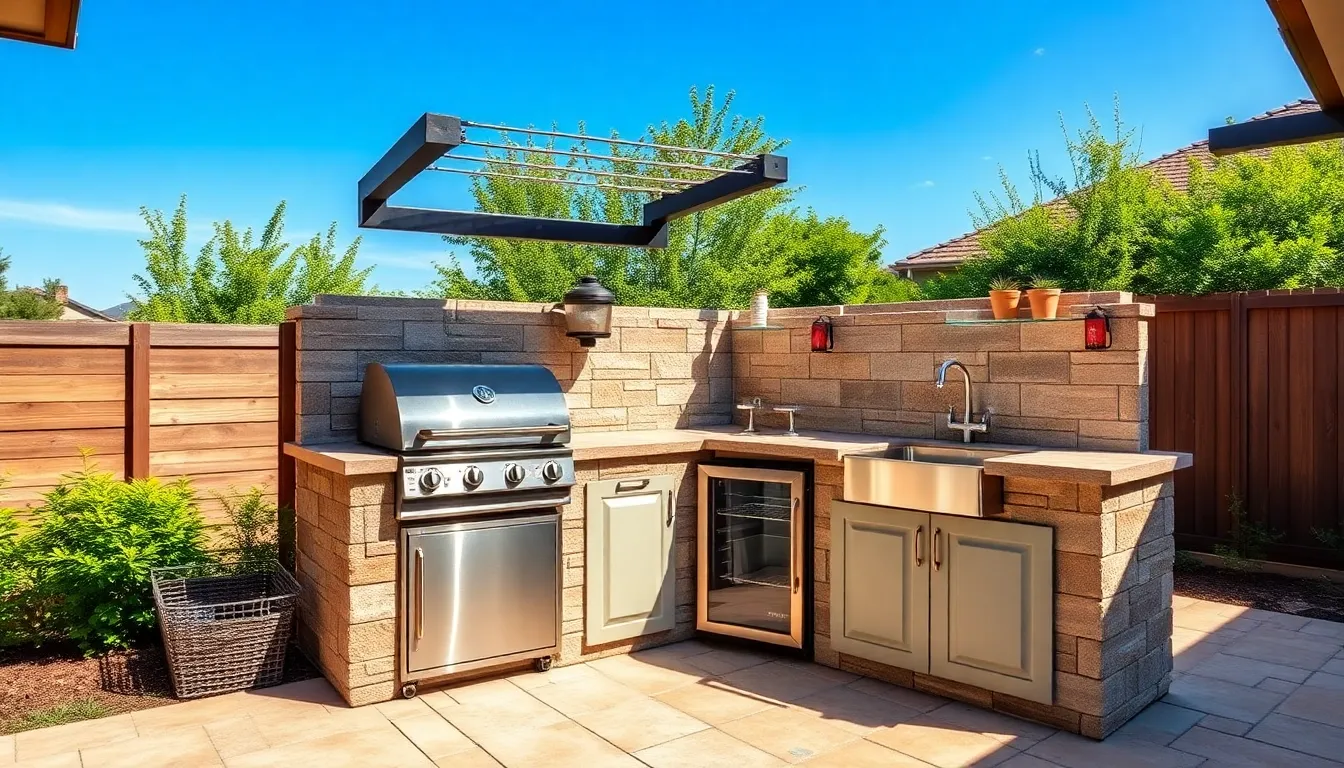
Creating a fully equipped corner BBQ kitchen transforms your outdoor space into a comprehensive cooking destination. We’ll explore essential amenities that maximize functionality while keeping everything within easy reach.
Include Refrigeration and Sink Options
Built-in refrigerator units keep beverages and ingredients chilled right where you need them most. Compact outdoor refrigerators eliminate constant trips to your indoor kitchen while maintaining optimal food temperatures during lengthy cooking sessions. Position your fridge within arm’s reach of the grill to streamline ingredient access and beverage service for guests.
Sink installation with running water becomes crucial for efficient food preparation and cleanup processes. Integrate your sink near cooking and prep areas to create a seamless workflow that saves time and effort. Running water allows for immediate hand washing, vegetable rinsing, and quick cleanup of utensils without disrupting your cooking rhythm.
Install Proper Electrical and Plumbing
Weatherproof electrical outlets power essential appliances like refrigeration units, lighting systems, and small kitchen gadgets safely. Install outlets that comply with outdoor safety codes and protect wiring from rain, moisture, and extreme temperatures. Position electrical connections strategically to avoid extension cord hazards while maintaining easy access to power sources.
Plumbing installation connects water supply and drainage lines to support your sink functionality effectively. Proper water lines ensure reliable access to fresh water for cooking and cleaning tasks. Drainage systems remove wastewater efficiently, maintaining cleanliness and preventing standing water issues that could damage your outdoor kitchen setup.
Create Dedicated Food Storage Areas
Weather-resistant cabinet storage organizes utensils, plates, grilling tools, and non-perishable items in designated spaces. Install cabinets with marine-grade finishes that withstand outdoor elements while keeping contents dry and accessible. Drawer systems separate different types of accessories, creating an organized system that speeds up cooking preparation and cleanup processes.
Ample countertop space and shelving near your grill provides convenient areas for food prep and temporary ingredient storage. Position counter surfaces at comfortable working heights to reduce strain during extended cooking sessions. Additional shelving holds frequently used items within easy reach, improving cooking flow and eliminating unnecessary movement between preparation areas.
Create a Budget-Friendly DIY Corner BBQ Space
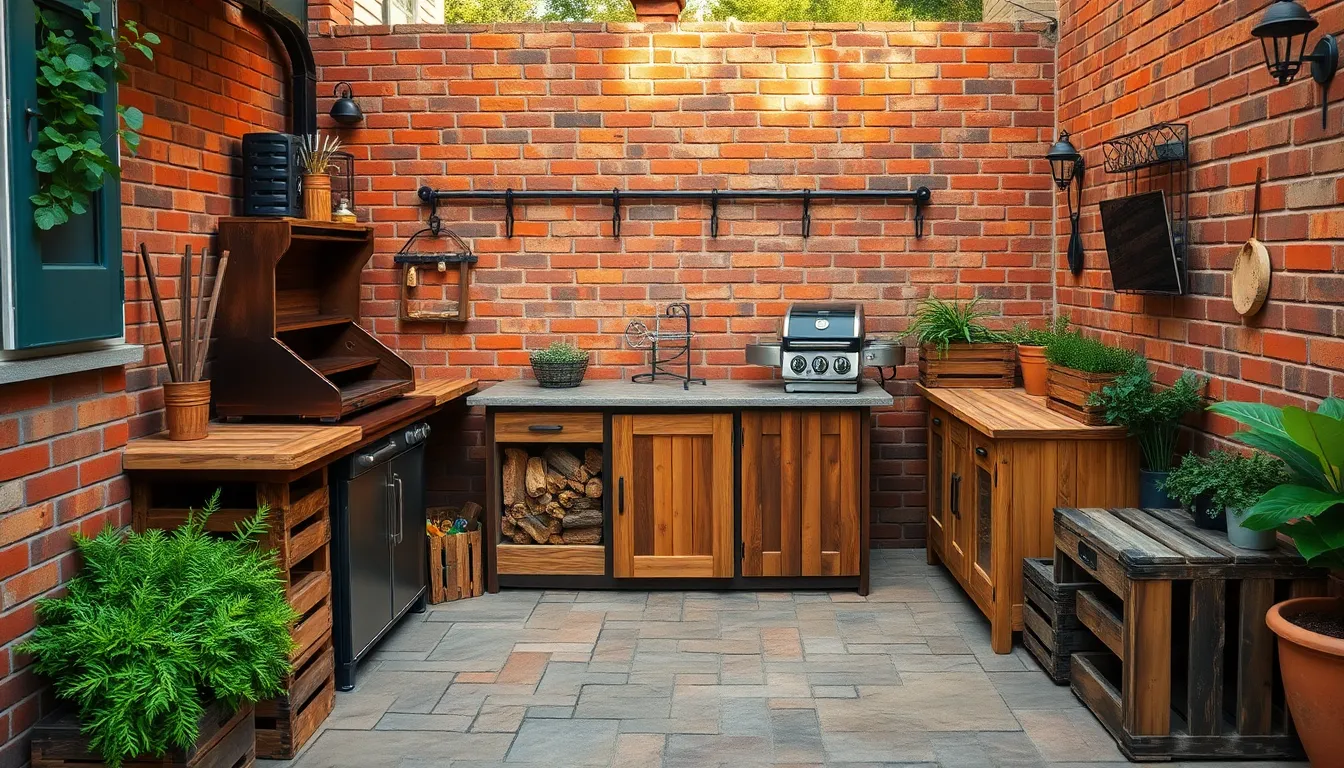
Building your dream corner BBQ area doesn’t require a hefty budget when you focus on smart material choices and clever design strategies. We’ll show you how to create a functional outdoor cooking space that maximizes your corner’s potential without very costly.
Use Repurposed Materials for Construction
Reclaimed bricks transform into stunning BBQ bases while adding authentic rustic character to your corner space. We love using old wooden pallets as foundations for prep tables and storage shelves since they’re often free from local businesses. Vintage wooden crates stack beautifully to create multi-level storage answers for grilling tools and supplies.
Salvaged stones work perfectly for creating natural-looking borders around your cooking area. These eco-friendly materials significantly reduce construction costs while giving your corner BBQ space unique personality. Old metal drums can be converted into charcoal storage containers or even modified into custom smokers.
Build Simple Concrete Block Structures
Concrete blocks offer unmatched versatility for creating L-shaped corner BBQ foundations at minimal cost. We recommend stacking blocks in a 45-degree angle configuration to maximize your corner’s natural geometry. Standard blocks cost approximately $1-3 each and require basic cement to secure them permanently.
Your block structure serves as the perfect base for mounting portable grills or building custom cooking surfaces. Stack blocks to create different height levels for prep areas and serving counters. Weather-resistant concrete handles outdoor elements better than wood while requiring virtually no maintenance.
| Block Configuration | Cost Range | Features |
|---|---|---|
| Basic L-Shape | $50-100 | Grill base, single counter |
| Multi-Level Design | $100-200 | Prep space, storage, grill area |
| Full Corner Kitchen | $200-400 | Multiple zones, bar seating |
Add Portable Accessories for Flexibility
Portable gas grills adapt perfectly to corner layouts while allowing you to move equipment based on wind direction and guest flow. We suggest investing in a quality Kamado cooker that provides both grilling and smoking capabilities in one compact unit. Foldable prep tables expand your workspace when needed and store easily during off-seasons.
Rolling carts serve as mobile command centers for grilling tools, seasonings, and serving platters. These accessories let you reconfigure your corner space for different occasions without permanent modifications. Collapsible bar stools provide seating that disappears when you need more cooking room.
Modular storage units stack and rearrange to accommodate changing needs throughout the grilling season. Weather-resistant covers protect your portable investments while maintaining the flexibility to upgrade individual components over time.
Plan Your Corner BBQ Layout for Maximum Efficiency
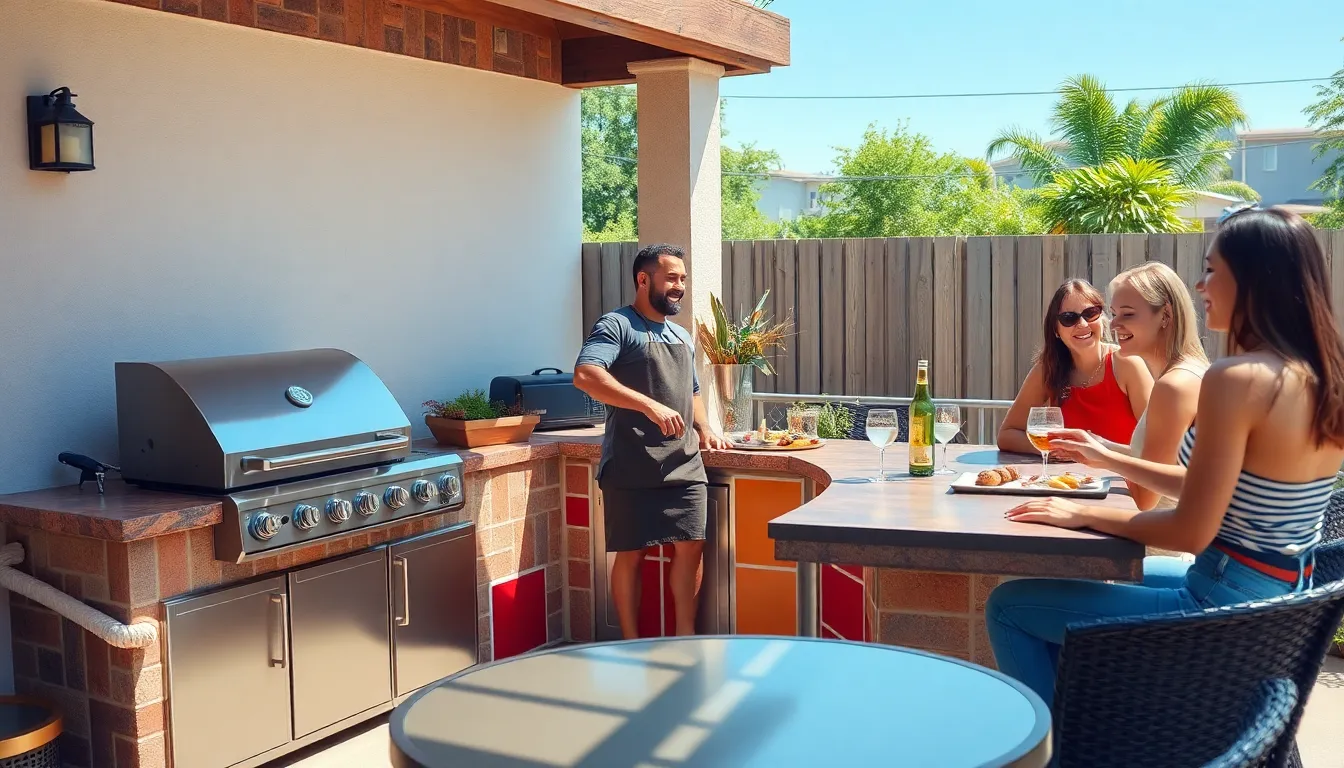
Smart corner BBQ layouts maximize every square inch while creating seamless cooking experiences. An L-shaped or 45-degree angled configuration transforms cramped spaces into functional outdoor kitchens that rival indoor setups.
Consider Traffic Flow Patterns
Separate cooking zones from guest areas to prevent crowding around hot grills and sharp tools. Position seating at least 4 feet away from the primary cooking surface, allowing the grill master to work without bumping into chairs or guests.
Create distinct pathways between cooking, serving, and dining zones using natural barriers like counter edges or built-in planters. Design your corner layout so guests can access drinks and appetizers without crossing through the active cooking area.
Install wrap-around bar seating along the outer edge of your L-shaped configuration to keep conversations flowing while maintaining safe distances from heat sources. This arrangement lets up to 6 people gather comfortably while staying out of the cook’s workspace.
Position prep areas between storage and cooking surfaces to create an efficient triangle that minimizes steps during meal preparation. Place cutting boards, seasoning stations, and utensil storage within arm’s reach of both the grill and sink areas.
Position Utilities for Easy Access
Locate gas connections within 10 feet of your primary grill location to avoid long hose runs that create tripping hazards and reduce gas pressure. Install shut-off valves in easily accessible spots that don’t require reaching over hot surfaces.
Run electrical lines to power essential appliances like refrigerators, lighting, and ventilation fans before building permanent structures. Plan for at least 4 GFCI-protected outlets distributed around your corner layout to avoid extension cord tangles.
Install water supply lines near prep and cleanup areas, positioning spigots at comfortable working heights between 36-42 inches from the ground. Connect to both hot and cold water if your budget allows for enhanced cleaning efficiency.
Design utility access panels within your cabinetry to simplify maintenance and repairs without dismantling entire sections. Use removable panels or hinged doors that provide clear access to shutoff valves, electrical connections, and plumbing fixtures.
Plan for Adequate Ventilation
Position grills on the open side of your corner configuration to take advantage of natural cross breezes that carry smoke away from seating areas. Avoid placing cooking surfaces directly against walls or under low overhangs that trap heat and fumes.
Install overhead ventilation using range hoods rated for outdoor use, positioning them 24-30 inches above cooking surfaces for optimal smoke capture. Choose models with variable speed fans that adjust to different cooking intensities and wind conditions.
Create airflow channels by leaving strategic gaps between built-in components, allowing natural ventilation to circulate around hot appliances. Design your corner layout with at least 6 inches of clearance on all sides of heat-generating equipment.
Add bi-fold doors or removable panels to enclosed sections of your corner BBQ area, providing emergency ventilation options during heavy cooking sessions. These features also protect equipment during off-seasons while maintaining airflow when needed.
Conclusion
We’ve explored countless ways to transform forgotten corners into amazing BBQ spaces that’ll become the heart of your outdoor entertaining. From rustic stone pits to modern L-shaped stations every approach offers unique benefits that maximize both functionality and style.
Whether you’re working with a tight budget using DIY answers or planning a fully equipped outdoor kitchen the key lies in smart layout planning and choosing the right materials. We’ve shown you how proper ventilation traffic flow and storage answers can make even the smallest corner space incredibly efficient.
Your corner BBQ area doesn’t have to be just another outdoor cooking spot—it can become a destination that brings family and friends together. With these ideas you’re ready to create an outdoor cooking space that’s perfectly customized to your needs and lifestyle.
Frequently Asked Questions
What are the main benefits of creating a corner BBQ area?
Corner BBQ areas offer natural wind protection, enhanced privacy, and create a cozy atmosphere for gatherings. They maximize space efficiency by utilizing neglected corners while providing more counter space and storage options than traditional straight-line setups. The corner configuration also creates distinct zones for cooking, prepping, and serving.
What materials are best for building a corner fire pit BBQ?
Heat-resistant materials are essential for safety and durability. Recommended options include fire bricks, granite, slate, and stainless steel. For rustic designs, natural stones like bluestone, sandstone, and flagstone work well. These materials can withstand high temperatures and weather conditions while maintaining their appearance over time.
How should I arrange seating around a corner BBQ area?
Arrange seating in a semi-circle formation to foster conversation and comfort. Incorporate various seating heights and include side tables for convenience. This configuration allows guests to interact with the cook while staying safely away from the grilling area, creating an inclusive and social atmosphere.
What storage solutions work best for small corner BBQ spaces?
Maximize vertical space with wall-mounted grill accessories and stackable storage units. Use modular drawer systems for organizing different accessories and consider built-in storage for grilling tools. Weather-resistant cabinets and under-counter storage help keep the area organized while preserving valuable counter space.
How do I ensure proper ventilation in a corner BBQ setup?
Install a chimney for proper smoke direction and ensure adequate height according to local building codes. Place the grill strategically to minimize smoke exposure to seating areas. Consider overhead ventilation systems and maintain proper spacing between cooking zones and guest areas for optimal air circulation.
What lighting options enhance evening BBQ gatherings?
Add ambient lighting through string lights, solar-powered path lights, and built-in LED strip lighting. Portable lanterns provide flexible illumination options. Combine multiple lighting sources to create a warm, inviting atmosphere while ensuring adequate visibility for safe cooking and socializing after dark.
Can I build a corner BBQ area on a budget?
Yes, use repurposed materials like reclaimed bricks, old wooden pallets, and salvaged stones to reduce costs. Build simple concrete block structures for versatile foundations. Incorporate portable accessories like gas grills and rolling carts for flexibility. Smart material choices and DIY construction can significantly lower expenses.
What utilities should I consider for a corner BBQ kitchen?
Plan for gas, electrical, and water line access to support outdoor appliances. Install proper electrical systems for lighting and equipment. Include plumbing for sinks and water features. Consider built-in refrigeration units and ensure all installations comply with local building codes for safety and functionality.

